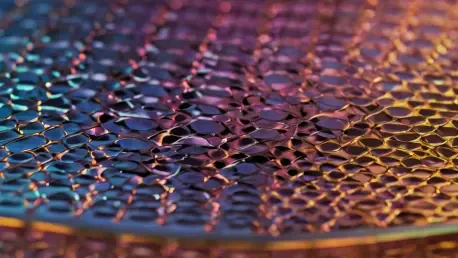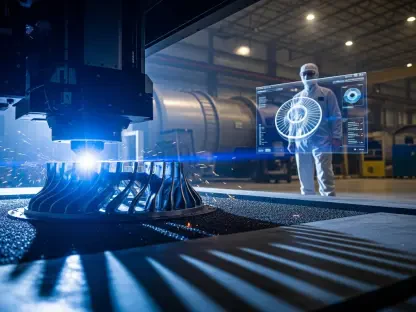Recent advancements in materials science have introduced a novel hybrid material that could revolutionize multiple tech sectors, known as glaphene. Developed by scientists at Rice University, glaphene is an innovative compound composed of two-dimensional (2D) layers of graphene and silica glass. This synthesis represents a substantial leap forward in the field, as it merges two inherently different 2D materials into a single entity. The research, published in Advanced Materials, suggests that glaphene could serve as a tailor-made solution for future electronic, photonic, and quantum technologies. These findings open new avenues for producing materials with custom-engineered attributes, paving the way for a range of applications.
Innovative Methods in Material Synthesis
A key factor in the emergence of glaphene is the innovative approach that researchers have employed, which diverges markedly from traditional methods of material layering. Conventional techniques often involve stacking atom-thick sheets with minimal interaction between them, akin to playing cards loosely piled. However, the methodology undertaken by the Rice University team allows for notable interaction at the atomic level. This is accomplished by facilitating electron movement between the layers, forming new bonds and vibrational states that give rise to unique properties absent in the individual materials. The process strengthens the connection between layers, surpassing the weak van der Waals forces typically associated with 2D assemblies, resulting in new behaviors and properties.
Sathvik Iyengar, a doctoral student and lead author of the research, underscores this advancement by pointing out the significant interaction where electrons traverse between layers, creating bonds that result in distinct vibrational states. This unique feature enhances the strength of the composite material, allowing for electron flow beyond what conventional methods achieve. By employing a two-step single-reaction process, researchers started with the growth of graphene from a chemical precursor containing silicon and carbon, subsequently fostering the development of a silica layer. This approach required creating a high-temperature, low-pressure apparatus through months of collaboration with Anchal Srivastava, showcasing an effective marriage of expertise and technology.
Vast Potential in Materials Engineering
The implications of glaphene extend beyond theoretical advancements, reaching into practical applications that could redefine various fields. The hybrid material embodies the possibility of custom-engineered 2D compounds that can bridge traditionally incompatible materials, such as pairing metals with insulators or aligning magnets with semiconductors. This opens vast opportunities for deploying these engineered materials across next-generation electronics, photonics, and quantum devices. By enabling the synthesis of bespoke materials from fundamental components, this innovation sets a precedent for tailored material science.
Crucial in realizing the potential of glaphene was the collaborative effort to verify and comprehend its structural and electronic properties. Following its synthesis, scientists at Rice collaborated with experts Manoj Tripathi and Alan Dalton from the University of Sussex. They employed Raman spectroscopy to detect novel signals revealing a deeper interaction between the layers that were distinct from either graphene or silica. These observations were instrumental in confirming the successful synthesis of glaphene, underlining the diligence and meticulousness inherent in scientific discovery. Through this interdisciplinary collaboration, the research team was able to interpret anomalous spectroscopic signals, enhancing their understanding of the material’s extraordinary strengths.
The Role of Global Collaboration
The development of glaphene serves as a testament to the power of global collaboration in scientific advancement. The research was not only the product of a single institution but also a coordination of efforts across various academic and geographical boundaries. Researchers consulted with global expertise, such as Marcos Pimenta for spectroscopic analysis and Vincent Meunier at Pennsylvania State University for quantum simulations. These simulations confirmed the existence of electronic interactions across the graphene-silica interface, indicating a drastic alteration in the material’s behavior compared to its individual components. Such findings opened up new classifications of semiconductors, fostering an entirely new understanding.
The research was supported by programs and funding from multiple countries, exemplifying the importance of international cooperation in cutting-edge scientific exploration. Associations such as the Quad Fellowship and numerous global research councils provided the foundation for this groundbreaking study. Achievements like these necessitate contributions from diverse scientific backgrounds and benefit from varied institutional resources. The successful synthesis and understanding of glaphene underscore the necessity of broad-based collaboration in material science research, demonstrating the collective ability to push the boundaries of technological development.
Pioneering Future Technologies
Recent breakthroughs in materials science have brought to light a fascinating hybrid material known as glaphene, potentially transforming various technology sectors. Engineered by researchers at Rice University, glaphene is a cutting-edge compound crafted from graphene and silica glass, both two-dimensional layers. The fusion of these distinct materials into a cohesive entity signifies a major advance in the field, promising to reshape future electronic, photonic, and quantum technology. As detailed in the journal Advanced Materials, glaphene emerges as a bespoke solution, unlocking potential for customized materials creation. Its unique properties could usher in a new era for technological applications, making it possible to tailor materials to specific needs. This development not only advances scientific understanding but also positions glaphene as a key player in material science, paving the way for innovations that could redefine industry standards in diverse sectors like computing, telecommunications, and beyond.









